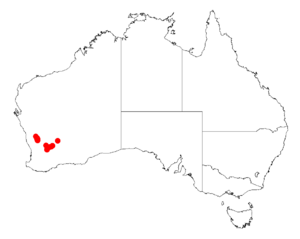Acacia glutinosissima facts for kids
Acacia glutinosissima is a type of shrub that belongs to the Acacia family. It's special because it only grows in western Australia. This plant is sometimes called a "wattle" in Australia.
Quick facts for kids Acacia glutinosissima |
|
|---|---|
| Scientific classification | |
| Genus: |
Acacia
|
| Species: |
glutinosissima
|
 |
|
| Occurrence data from AVH | |
What Does This Acacia Look Like?
This shrub is usually quite tall, growing from about 1.8 metres (6 ft) to 3.0 metres (10 ft) high. It has a rather thin, open shape with not many branches. The plant feels sticky, which is what "viscid" means.
Its small branches feel rough. This roughness comes from tiny bumps where its leaves used to be. The plant also has small, thin leaf-like parts called stipules, which are about 2 to 5 mm (0.079 to 0.197 in) long. These fall off as the plant grows.
The leaves of this acacia are called phyllodes. They are long and thin, growing upwards. They can be green or yellowish-green. Each phyllode is about 9 to 17 cm (3.5 to 6.7 in) long and 2 to 3.5 mm (0.079 to 0.138 in) wide.
This plant produces bright yellow flowers. You can see them from July to September. The flowers grow in round clusters, like little balls. Each cluster is packed with 40 to 55 golden flowers.
After the flowers, long, thin seed pods grow. These pods can be up to 10 cm (3.9 in) long and about 3.5 to 4.5 mm (0.14 to 0.18 in) wide. Inside the pods are oblong or oval-shaped seeds, each about 4 to 4.5 mm (0.16 to 0.18 in) long.
Where Does This Acacia Grow?
Acacia glutinosissima is found only in the Wheatbelt area of Western Australia. It grows in specific places like small hills and flat, sandy areas.
You can find it in soils that are gravelly, sandy, or made of a reddish soil called laterite. It grows in open scrubland, which means areas with scattered bushes and small trees.
Its distribution is spread out. You might find it near towns like Wubin in the north. It also grows further south, around Bruce Rock.

